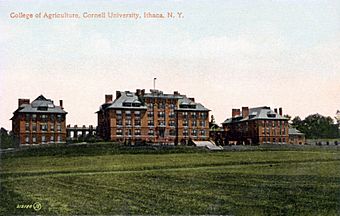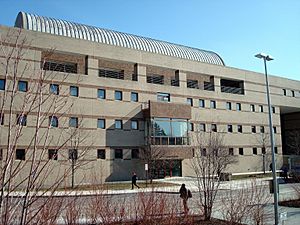Roberts Hall (Ithaca, New York) facts for kids
Quick facts for kids |
|
|
Roberts Hall
|
|

Stone Hall, Roberts Hall, and East Roberts Hall were the first buildings of the New York State College of Agriculture
|
|
| Location | Cornell University campus, Ithaca, New York |
|---|---|
| Built | 1905-1906 |
| Architect | George L. Heins, Morris Kantrowitz, |
| Architectural style | Beaux Arts, Renaissance |
| Demolished | 1988 |
| MPS | New York State College of Agriculture TR |
| NRHP reference No. | 84003191 |
| Added to NRHP | September 24, 1984 |
Roberts Hall was the first building of the New York State College of Agriculture at Cornell University, built 1905–1906, and demolished c. 1988. A second building of that name was built in 1989.
Original building
New York state legislation provided $125,000 for the construction of a building for the newly designated New York State College of Agriculture. The building was constructed in three parts to comply with the act's restriction on spending for a single building. These were Stone Hall, Roberts Hall, and East Roberts Hall, named for director of the College of Agriculture from 1874 to 1903, Isaac Phillips Roberts. The trio of buildings were built in 1905-1906 along Tower Road. East Roberts served as the new Dairy Building, as the old Dairy Building was merged into Goldwin Smith Hall. The three buildings were determined in 1973 to be decrepit, and despite being listed on the U.S. National Register of Historic Places in 1984, Cornell had them demolished in 1988 over the protest of local preservationists. Kennedy-Roberts Hall was built in 1989 to replace Roberts-Stone Halls.
The 1906 building is still listed on the National Register, apparently erroneously as nothing remains of the building. East Roberts Hall and Stone Hall are similarly listed.
Condemnation and demolition
In 1973, Franzen and Associates, the architectural firm that was designing Cornell's statutory college buildings at that time, conducted a study indicating that Roberts, East Roberts, Stone, Caldwell and Comstock Halls were unsafe and should be condemned. Franzen concluded that it would cost $14 million to renovate the five buildings and that it would be cheaper to tear them down and replace them with new buildings, presumably designed by Franzen. (Ironically, as of 2010, Caldwell and Comstock Halls are still in use, but another Franzen-designed building, the north wing of Martha Van Rensselaer Hall, had to be demolished as structurally unsound.) By 1978, the cost of demolishing the five buildings and building two replacements had escalated to $18 million. In response, two groups, Historic Ithaca and a student-group called the "Ag Quad Preservation Society" applied to list the five buildings on the National Register and sought to protect them under a newly enacted Ithaca historic preservation ordinance. Just before Historic Ithaca could gain a court injunction to stop the demolition of Roberts, East Roberts and Stone Halls, Cornell began the demolition. The State of New York renovated Caldwell and sold Comstock back to Cornell for use as a computer center.
Gallery
Kennedy-Roberts Complex
Kennedy Hall and the ″new″ Roberts Hall are one large complex, joined together with access between each through the ground floor and the fourth floor. On the first floor of Kennedy Hall is the David L. Call Alumni Auditorium, also known as 116 Kennedy Hall. The Call Auditorium jets out from Kennedy Hall to the east. Outside, to the north of the auditorium, is a small plaza, complete with seating and an area of shrubs and trees in a large planting bed directly abutting the building. The planting was designed and executed in the spring of 2011 by students in a cross-listed landscape architecture (LA) and horticulture (HORT) class as part of their curriculum. The class, LA/HORT 4910/20 — Creating the Urban Eden: Woody Plant Selection, Design, and Landscape Establishment, was co-taught by Peter J. Trowbridge and Nina Bassuk.







